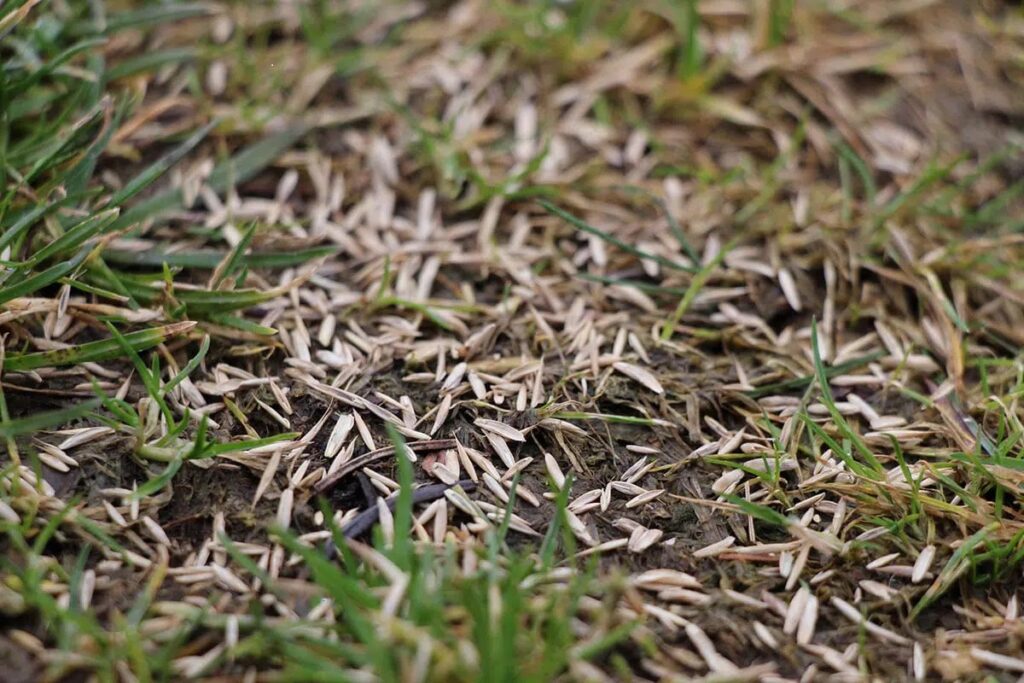A beautiful green lawn should not be missing in any garden, whether as an ornamental lawn or play area for romping children. It is not only the type of lawn that is important, but also the amount sown. We answer the question of whether you can sow too much lawn seed.
- too much lawn seed harms
- otherwise seedlings develop poorly
- eventually many die
- depending on the lawn mixture, sow 30 to 40 g per square meter
- Always calculate the ideal quantity correctly
Contents
Large quantities can do harm
Many an amateur gardener is guided by the motto “a lot helps a lot” when laying out a lawn, perhaps in order to achieve a beautiful green and dense lawn more quickly. However, this guiding principle should not be followed when sowing lawn seed. Only with a correct dosage of seed will permanently develop a sustainable and very robust lawn. On the other hand, if you sow too much lawn seed, this can have serious consequences, because from one seed grows a grass plant size 8 x 8 cm:
- young seedlings compete for water, nutrients and light.
- plant roots get little air
- plants hinder each other during development and growth
- increased death of seedlings
- formation of increased lawn felt
- thus poorer aeration of the soil and the lawn surface
- frequent dethatching of the lawn
- sometimes change in the composition of the lawn mixture
- as some varieties are more competitive than others
- thus also change in the properties of the mixture (resilience etc.)
In addition, insufficient application of appropriate seed also has a decisive effect on the establishment of a lawn, for example
- bare patches in the lawn
- larger spaces between individual grass plants
- rapid spread of weeds such as horn clover, dandelion or daisies
For the previously mentioned reasons, it is therefore important to know the exact amount of lawn seed needed.
Note: Most lawn mixtures consist mainly of two different grass species, bluegrass (Poa pratensis) and European ryegrass (Lolium perenne). Depending on the use, the mixing ratio varies.
Calculating the ideal quantity
Individual manufacturers provide application instructions on their packaging regarding the quantity so that you do not sow too much lawn seed. However, it must be said that not every lawn mixture is the same here. Thus, as a rule, 30 to 40 g per square meter is specified depending on the type of lawn:
- Sports and play lawn average 30 g per square meter.
- ornamental lawn 25 g per square meter
- for gap filling 5 g per square meter
In addition, the manufacturer’s specifications can also vary, especially with low-quality seed, i.e. cheaper varieties, larger quantities are often required because the germination rate is low. In general, the following formula should be used when calculating the ideal amount of seed:
Seeding area in square meters x amount of seed in g per square meter (found on packaging) = amount of seed needed.
Here is an example: 100 square meters of area x 30 g of seed per square meter = 3000 g
You should then not use more seed for this area either.

Note: Not only the ideal amount of seed is important for success, but also the right time of sowing. The soil temperature should always be above 10 °C. The months of April / May and August / September are ideal for this.
Correct technique
Even with an incorrect sowing technique, you may not be able to spread the lawn seed over a wide area and will sow too little or too much in isolated spots. Therefore, keep the following in mind when seeding:
- Divide area into three or four pieces
- Spreading with a spreader
- adjust it correctly
- drive it piece by piece
- at the end drive again in cross direction over the area
- lightly distribute smaller heaps of seed with a rake
- when spreading by hand, go backwards
- distribute seed evenly with a sweeping motion
Note: Work in lawn seed only lightly with the rake, do not cover with soil (light germinators). Then press down well with a roller, alternatively tread down with a board.
Frequently asked questions
How should prepare the soil for sowing a lawn?
The soil must be freed from stones, branches or root remains. This requires deep loosening, either with a power hoe or a spade. The soil is then leveled with a rake and consolidated with a lawn roller. Alternatively, the soil can be left for two weeks to firm up. It is then roughened slightly with the rake before sowing.
What care does the lawn seed need after sowing?
As a rule, the lawn seed germinates after eight to 14 days. However, for this it needs sufficient moisture. Regular watering is now necessary. The area should be watered mainly in the morning or evening hours for about 10 to 15 minutes. Make sure that the water jet is not too hard, otherwise the seeds will be washed out. Optimal here would be the use of lawn sprinklers for uniform watering of the area.
When should the newly sown lawn be mowed?
The lawn should be mowed for the first time when it is eight to ten centimeters high. Then the young grass plants have sufficiently rooted in the soil. The lawn mower should be set at a height of between five and six centimeters. After that, mowing weekly or every fourteen days is advisable, but not at temperatures above 30 °C, otherwise the young grass blades will burn. After eight weeks at the latest, the lawn will then be fully resilient.


